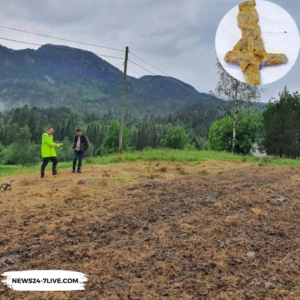A archaeological discovery was made on a family farm in Norway’s southwestern Rogaland district. A part-time farmer and ferry engineer, Øyvind Tveitane Lovra unearthed a 1,000-year-old Viking sword while clearing a field. Initially mistaken for a piece of old iron, the artifact was later identified as a rare type of iron sword likely produced in the Frankish Empire.

Also Read: 2,300-Year-Old Gold Ring Unearthed in Jerusalem’s City of David
Øyvind Tveitane Lovra, a part-time farmer, ferry engineer and local politician in the Suldal municipality, Rogaland district, southwestern Norway.
Lovra was preparing to sow grass in a field that had not been plowed for many years. Lovra almost discarded the object, mistaking it for scrap metal. Closer inspection revealed its true nature, prompting him to contact local archaeologists.
The sword is from the Viking Age, specifically estimated to have been made between A.D. 900 and 1050. The remnant of the sword is approximately 37 centimeters (14.5 inches) long with half of the blade missing.
The sword’s preservation is given Rogaland’s soil conditions which are typically not conducive to preserving iron artifacts.
The dense clay in which the sword was embedded played a crucial role in preventing it from rusting away.
X-ray scans revealed the contours of an inscription on the blade suggesting it could be an Ulfberht sword. These swords were high-quality weapons produced in the Frankish Empire now modern-day Germany and France.
Lars Søgaard Sørensen, a Rogaland government archaeologist, addressed the rarity of such finds, stating, “The sword was the greatest status symbol in the Viking Age, and it was a privilege to be allowed to wear a sword.”
Sigmund Oehrl, a professor of archaeology at the University of Stavanger, confirmed the significance of the inscriptions.
He said that only about 4,000 Viking Age swords have been discovered across Europe with merely 170 of them bearing Ulfberht inscriptions. In Norway only 45 such swords have been found and this is the first of its kind discovered in Rogaland.
The period from A.D. 793 to 1066, characterized by Norse explorations, trade, and warfare. These were known for their superior craftsmanship and were marked with the weapon manufacturer’s name. Their production was centered in the Frankish Empire during the Viking Age and the early Middle Ages.
Also Read: Scientists Discover ‘Echidnapus’ in Lightning Ridge Opal Fields
Details:
- Historical Period: Viking Age, dating between 900 and 1050 C.E.
- Type of Sword: Potential Ulfberht sword, renowned for high quality and craftsmanship
- Current Length: 15 inches (37 cm)
- Original Length: Approximately twice the current length
- Condition: Well-preserved due to dense clay soil, despite thick corrosion crust
- Inscription: X-ray imaging revealed cross patterns and possible letters indicating the sword might be a VLFBERHT sword
- Archaeologists Involved: Lars Søgaard Sørensen and Kim Thunheim
- Metal Detection: No additional historic relics found at the site
- Transfer for Analysis: Sword sent to the Archaeological Museum of the University of Stavanger for further study.
- Production: Made in the Frankish Empire (modern-day Germany)
- Distribution: Approximately 170 known examples across Europe, with 45 found in Norway
- Rogaland County: First discovery of an Ulfberht sword in this region
- River Cherwell, November 2023: Viking sword uncovered
- Setesdal, Norway: Sword found in a Viking warrior’s grave
- Exhibition: NTNU University Museum in Central Norway will showcase 700 Viking swords in June 2024.
- Cultural Heritage Act: Requires reporting and surrendering of historical artifacts to the state
- Ownership: All finds falling under sections 12 and 14 of the Act are state property
- Determine Precise Age: Using advanced dating techniques
- Interpret Inscriptions: Deciphering the cross patterns and letters for historical insights.
Professor Sigmund Oehrl Confirmed the sword’s significance and its status as a Ulfberht sword. Hege Hollund, Conservator at the Archaeological Museum addressed the exceptional preservation.
Ulfberht swords were crafted using superior raw materials and advanced techniques. Detailed imaging showed inscriptions possibly reading “VLFBERHT.”
Swords like this were symbols of status and privilege in Viking society. According to the Gulating Law, free men were required to carry swords to assemblies.
The sword’s blade and handle are remarkably intact. The sword will undergo cleaning and further preservation to study its inscriptions and historical context.
Once conservation is complete, the sword is expected to be displayed in museums contributing to the understanding of Viking culture and craftsmanship.
Also Read: Koleken Inakayali: New Dinosaur Species with Tiny Arms Discovered in Patagonia























